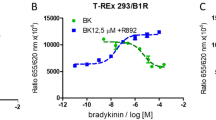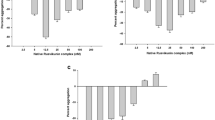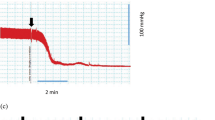Abstract
THE venom from Bothrops jararaca contains enzymes which liberate kinins from plasma kininogen1. Ferreira2 found that the venom also contained a peptidic fraction (bradykinin potentiating factor, BPF) which potentiated the actions of bradykinin on various isolated organs and on the blood pressure of the cat. This potentiating action was later correlated with an inhibition of kinin-destroying enzymes3–5. Recently BPF has been separated into several different active fractions and the amino-acid composition of nine purified peptides has been established6. The structure of the smallest of the peptides (V-3A), a pentapeptide, has been established (pGa-Lys-Trp-Ala-Pro) and the material has been synthesized7. Ferreira, Bartelt and Greene6 also measured the bradykinin-potentiating activity of these different purified peptides on the isolated ileum from the guinea-pig as an indication of their ability to inhibit kininases.
This is a preview of subscription content, access via your institution
Access options
Subscribe to this journal
Receive 51 print issues and online access
$199.00 per year
only $3.90 per issue
Buy this article
- Purchase on Springer Link
- Instant access to full article PDF
Prices may be subject to local taxes which are calculated during checkout
Similar content being viewed by others

References
Roche e Silva, M., Beraldo, W. T., and Rosenfeld, G., Amer. J. Physiol., 156, 261 (1949).
Ferreira, S. H., Brit. J. Pharmacol. Chemother., 24, 163 (1965).
Ferreira, S. H., and Roche e Silva, M., Experientia, 21, 347 (1965).
Ferreira, S. H., in Hypotensive Peptides (edit. by Erdös, G., Back, N., and Sicuteri, F.), 356 (Springer-Verlag, NY, 1966).
Ferreira, S. H., and Vane, J. R., Brit. J. Pharmacol. Chemother., 29, 367 (1967).
Ferreira, S. H., Bartelt, D. C., and Greene, L. J., J. Biol. Chem. (in the press).
Greene, L. J., Stewart, J. M., and Ferreira, S. H., J. Biol. Chem. (in the press).
Bakhle, Y. S., Nature, 220, 919 (1968).
Bakhle, Y. S., Reynard, A. M., and Vane, J. R., Nature, 222, 956 (1969).
Ng, K. K. F., and Vane, J. R., Nature, 216, 762 (1967).
Ng, K. K. F., and Vane, J. R., Nature, 218, 144 (1968).
Oparil, S., Sanders, C. A., and Haber, E., Fed. Proc., 28, 580 (1969).
Regoli, D., and Vane, J. R., Brit. J. Pharmacol. Chemother., 23, 351 (1964).
Author information
Authors and Affiliations
Additional information
The erratum article can be found online at https://doi.org/10.1038/225981c0
Rights and permissions
About this article
Cite this article
FERREIRA, S., GREENE, L., ALABASTER, V. et al. Activity of Various Fractions of Bradykinin Potentiating Factor against Angiotensin I Converting Enzyme. Nature 225, 379–380 (1970). https://doi.org/10.1038/225379a0
Received:
Published:
Issue Date:
DOI: https://doi.org/10.1038/225379a0
This article is cited by
-
Counter effect of bee venom and its extracted bradykinin-potentiating factor on acrylamide and chips administration-induced complications in the liver and kidney of male mice
The Journal of Basic and Applied Zoology (2018)
-
The toxicity of angiotensin converting enzyme inhibitors to larvae of the disease vectors Aedes aegypti and Anopheles gambiae
Scientific Reports (2017)
-
ACE for all – a molecular perspective
Journal of Cell Communication and Signaling (2014)
-
Combination inhibition of the renin–angiotensin system: is more better?
Kidney International (2011)
Comments
By submitting a comment you agree to abide by our Terms and Community Guidelines. If you find something abusive or that does not comply with our terms or guidelines please flag it as inappropriate.


